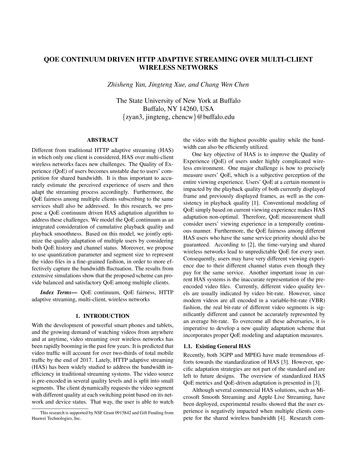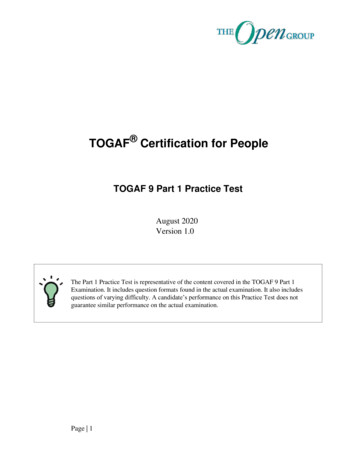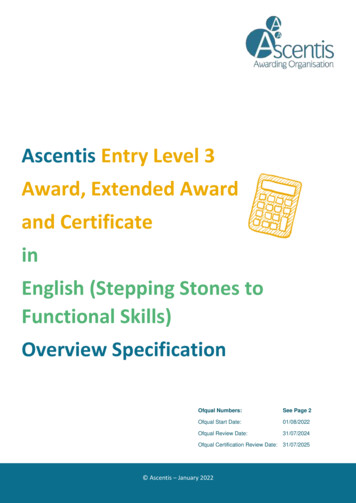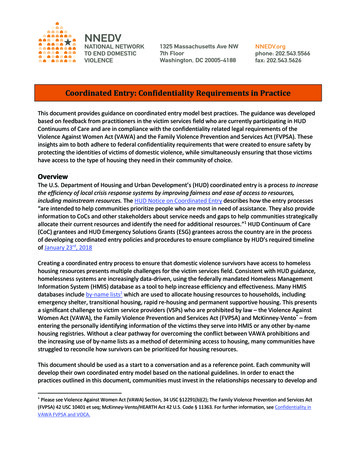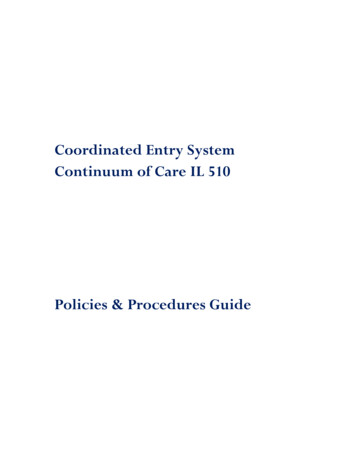
Transcription
Coordinated Entry SystemContinuum of Care IL 510Policies & Procedures Guide
Coordinated Entry System Continuum of Care IL 510: Policies & Procedures Guide DRAFTContentsCoordinated Entry System (CES) Overview .4What is Coordinated Entry.4Chicago’s CES Goal/Community Vision .4Chicago’s CES Lead Entities .4Multiple Access Points and Consistency of Services .5Agencies Required to Use the CES .5Roles, Targeting, and Populations .5Roles .5Targeting Resources: Standardized Housing Assessment .6Single Adults – VI-Plus .7Households with Children under 18 - Family VI.7Unaccompanied Young Adults Age 18-24 – Youth VI .8Minors .8Targeting Beyond Vulnerability Assessments .8Coordinated Entry System Work Flow .9Assessment .9Observational Assessment .9One List . 11Active List . 11Inactive List . 11Matching . 11Veteran Matching . 12Special Populations . 122
Coordinated Entry System Continuum of Care IL 510: Policies & Procedures Guide DRAFTDomestic Violence Survivors. 12Ending Veteran Homelessness Initiative. 13Providers . 13Crisis Response Providers . 13Transitional and Permanent Housing Providers . 14Verifying Chronic Homelessness . 14Program Transfer Policies & Process . 18Non-Discrimination . 19Data Management . 20Evaluation . 213
Coordinated Entry System Continuum of Care IL 510: Policies & Procedures Guide DRAFTCoordinated Entry System (CES) OverviewWhat is Coordinated EntryCoordinated entry is a centralized and streamlined system for accessing housing and support servicesto end homelessness in a community, and is required by the U.S. Department of Housing and UrbanDevelopment for all Continuums of Care (CoC) as stated in 24 CFR 578.7 (a)(8) of the Continuum ofCare Program Interim Rule. “HUD’s primary goals for coordinated entry processes are that assistancebe allocated as effectively as possible and that it be easily accessible no matter where or how peoplepresent1.” Such a system incorporates a community-wide Housing First approach to all programs andprioritizes resources for those with the most complex needs.Coordinated entry processes help communities prioritize assistance based on vulnerability and severityof service needs to ensure that people who need assistance the most can receive it in a timely manner.Coordinated entry also provides vital information to communities about service needs and gaps to helpcommunities plan their assistance and identify needed resources.2 Utilizing a standardized assessmenttool and practices, the goal is for the system to ensure that households experiencing homelessnesshave equal and fair access to resources that will end their homelessness.All programs receiving Federal and State funds will comply with applicable civil rights and fair housinglaws and requirements, and recipients and sub-recipients of CoC Program and ESG Program-fundedprojects must comply with the nondiscrimination and equal opportunity provisions of Federal civilrights laws.Chicago’s CES Goal/Community VisionChicago’s vision for coordinated entry is a community response to ending homelessness that accountsfor the diversity of needs of people experiencing homelessness, urgently responds to these needs withpermanent housing solutions, and successfully incorporates the housing, healthcare, and employmentsystems. This community response will ensure an accessible and navigable set of entry points; auniversal assessment for all person requesting assistance; and effective and appropriate connections tohousing and services for all populations. Chicago’s CES will include a data driven approach to ensurethat the system is able to measure and respond to current needs with a transparent framework ofsharing progress.Chicago’s CES Lead EntitiesCSH: Lead Entity and project manager of the CES, ChicagoCES@csh.orgAll Chicago: HMIS Lead for the Chicago Continuum of Care, hmis@allchicago.orgCatholic Charities: System Administrator (including matching households to housing) and Diversion,ChicagoCES@CatholicCharities.netCenter for Housing and Health: CenterCES@housingforhealth.orgUniversal Data Platform: Homeless Management Information System (HMIS)HMIS is the data platform utilized for CES activities. Skilled Assessors conduct the Chicago CoCStandardized Housing Assessment with persons experiencing homelessness and enter this data intoHMIS. Housing providers will receive all matches through the CES via HMIS, along with the homelessprograms the household has been or is currently enrolled in to support locating the Applicant. Inaddition, HMIS will be utilized to track the community’s progress in ending homelessness.12The Department of Housing and Urban Development, Coordinated Entry Policy Brief, (2015)The Department of Housing and Urban Development, Coordinated Entry Policy Brief, (2015)4
Coordinated Entry System Continuum of Care IL 510: Policies & Procedures Guide DRAFTMultiple Access Points and Consistency of ServicesAccess points ensure that people experiencing homelessness have the ability to meet with a SkilledAssessor to complete the Chicago CoC Standardized Housing Assessment, the first step towardsmovement to permanent housing coordinated through the CES. Chicago utilizes existing serviceproviders as access points for the system and plans to expand access points to additional entities thatencounter people experiencing homelessness. These access points cover and are accessible throughoutChicago and will be affirmatively marketed to eligible persons regardless of race, color, national origin,religion, sex, age, familial status, disability or who are least likely to complete a Coordinated EntrySystem Housing Assessment in the absence of special outreach.Various access points will accommodate cohorts within the population such as youth, Veterans,families, survivors of domestic violence, and adults experiencing either homelessness or chronichomelessness to ensure fair and equal access for all populations into the coordinated entry process.While marketing will encourage people who are part of a particular cohort to connect with particularaccess points, any person will be accommodated at any access point.*Please see Access Points in the Appendix for a listing of participating agencies along with the scheduleand contact information for each location.Agencies Required to Use the CESAll Agencies serving households experiencing homelessness are encouraged to use the CES forreferrals. Agencies receiving Housing and Urban Development (HUD) Continuum of Care (CoC) and Cityof Chicago Department of Family and Support Services Homeless funding must use the CES.Roles, Targeting, and PopulationsRolesThese are the roles in the CES process:Applicant: People experiencing literal homelessness including individuals and households of more thanone person needing permanent housing. Applicants must be in the City of Chicago, and their currentliving situation meet the definition of homelessness according to the Homelessness Emergency andRapid Transition to Housing (HEARTH) Act. Youth under the age of 25 who are unstably housed willmeet the homeless definition for programs funded to serve this population.Authorized User Agencies: Housing providers who wish to or are required to participate in the CES.Coordinated Access Steering Committee (CASC): This entity is the governing body of the CES. Previously,this steering committee served in a planning capacity and has shifted to oversight of the planning andimplementation of CES.Coordinated Entry Lead: CSH is the lead agency for the Coordinated Entry Supportive Services Only(SSO) grant. CSH serves as the project manager for CES implementation.Emergency Services: Emergency services such as shelters and drop-in centers may serve as accesspoints to the Coordinated Entry System by connecting people to a Skilled Assessor. People will be ableto access emergency services independent of the operating hours of the system’s intake assessmentprocess for CES.Diversion Specialist: Catholic Charities and Salvation Army will work to divert households from shelteras appropriate. People who cannot be assisted with identifying and accessing safe housing will bewelcomed into the shelter system. The purpose of diversion is to prevent the need for homeless5
Coordinated Entry System Continuum of Care IL 510: Policies & Procedures Guide DRAFTresources with connections to mainstream resources, support with identifying potential members ofthe Applicant’s support network, and conflict resolution or mediation if needed.HMIS Administrator: All Chicago is the CoC HMIS Lead. All Chicago provides training for new users ofthe HMIS system and Coordinated Entry System. All Chicago creates agency and staff new userprofiles. All Chicago manages the CES by name list known as the One List, which is used to prioritizeand match applicants to housing. All Chicago provides reporting on outcomes as requested by theCoordinated Entry Lead.Homeless Prevention Call Center: The Homeless Prevention Call Center manages requests for homelessprevention resources. People should call 311 and ask for short term help.Housing System Navigator: Once a housing option is identified, a Housing System Navigator assists theApplicant with reaching housing. Housing System Navigators may assist Applicants with gathering thenecessary documentation needed to complete formal housing applications. Families and peopleexperiencing chronic homelessness who require navigation support and are not already linked to anOutreach Worker or Case Manager able to provide this level of support will be matched to a HousingSystem Navigator as capacity allows.Outreach Worker: Outreach Workers assist the Applicant in accessing the CES, including assisting theApplicant in getting to a drop-in center to complete a Standardized Housing Assessment. Outreachworkers may also be Skilled Assessors. Once a housing option is identified, Outreach Workers mayserve as a secondary contact between Agencies and Applicants. Outreach Workers may assistApplicants with gathering the necessary documentation needed to complete formal housingapplications.Shelters and Interim Housing: Access to emergency shelter and interim housing resources will notchange. For households in need of emergency shelter, they may access resources via DFSS ServiceCenters, hospitals and police stations by calling 311. Crisis response programs will not create barriersto entry such as requiring a CES assessment for entry. Emergency services staff will connect householdsto the CES by offering space to Skilled Assessors, informing participants of the CES process and how tocomplete a CES assessment, and in some instances serving as an access point.Skilled Assessor: Person who can complete coordinated entry assessments with Applicants. SkilledAssessors are trained to complete the coordinated entry assessments, enter data into HMIS, and obtainsigned required confidentiality agreements.System Coordination – Matchers: Catholic Charities/matcher utilizes HMIS to review assessments andsend appropriate matches to housing providers with vacancies and in need of referrals. The matchingentity reviews the response to the referral and will connect the individual to subsequent housingoptions as needed.System Coordination – Outreach Coordination: The Center for Housing & Health (CHH) manages theOutreach Coordination process. This will include leading System Integration Teams and supportingcoordination between outreach and housing providers to efficiently house Applicants.Targeting Resources: Standardized Housing AssessmentThe CES is open to all households who meet the HUD definition of experiencing homelessness. TheCoordinated Entry standardized assessment is open to all individuals/households experiencinghomelessness and is separated into sections which assist in determining homelessness, vulnerability,barriers, and other criteria related to eligibility for housing programs.The CES for permanent supportive housing uses vulnerability indices (described below) to rankApplicants in order of vulnerability, with the most vulnerable households at the top of the list. More6
Coordinated Entry System Continuum of Care IL 510: Policies & Procedures Guide DRAFTdirectly, Applicants may be offered housing regardless of vulnerability score, but more vulnerablepersons will likely be offered housing before less vulnerable persons. Applicants will be prioritized inthe following order:1) Chronic Homelessness first,2) VI Score (descending) second,3) Number of days homeless (descending) third,4) Date of application last.Chicago has adopted a practice of filling all supportive housing units with people facing chronichomelessness first. If no person facing chronic homelessness can be found for the unit the level ofacuity will be taken into consideration as the next priority.PSH referrals will not be assigned to different levels of service within PSH based on vulnerability scores.Instead, households will be matched based on availability, system-wide eligibility, and prioritizationcriteria.Programs with a less intensive and ongoing service model can accommodate people with a lower VIscore who may or may not be facing chronic homelessness. Those with lower acuity and facing chronichomelessness will be prioritized above those with lower acuity who are not facing chronichomelessness for permanent housing with short term supports and rapid rehousing programs.Permanent Housing with Short Term Supports, Permanent Housing without supports, and RapidRehousing programs are geared towards households with a lower vulnerability score who may or maynot be experiencing chronic homelessness. Transitional housing programs can accommodate anyperson who meets their funder driven eligibility criteria with a preference for those fleeing domesticviolence and prioritizing the most vulnerable.*Please see the Appendix for the Program Models Chart to view a full description of each model.Single Adults – VI-PlusThe Vulnerability Index (VI) is an assessment tool used to identify members of the homelesspopulation who are considered medically vulnerable and who will face an increased risk of mortality ifhomelessness persists. Chicago adapted the VI to screen for and identify households with SevereMental Illness (SMI) who are in need of the Safe Haven program model. Scores for single adults rangefrom 0 to 8 with one point for each challenge listed below: Three or more hospitalizations or emergency room visits in a year Three or more emergency room visits in the previous three months Age 60 or older Cirrhosis of the liver End-stage renal disease History of frostbite, immersion foot, or hypothermia HIV /AIDS Tri-morbidity: co-occurring psychiatric, substance abuse and chronic medical condition (asthma,cancer, diabetes, etc.)Households with Children under 18 - Family VIFamily Vulnerability is characterized by length of literal homelessness and residential instability,involvement with child welfare and/or informal separation from children, number of children, andtrauma history. The minimum score is 1 and there is no maximum score, as each child in the householdreceives .5 to 1 point. The Family VI assessment asks questions in the following areas to calculate the VIscore:7
Coordinated Entry System Continuum of Care IL 510: Policies & Procedures Guide DRAFT Homeless historyInvolvement with child welfareParental risk factorsChild risk factorsUnaccompanied Young Adults Age 18-24 – Youth VIUnaccompanied youth vulnerability is characterized by likeliness to remain homeless for a longduration. The minimum score is 1 and the maximum is 6. The Youth VI assessment asks question in thefollowing areas to calculate the VI score: Reason for homelessness History of juvenile detention History of drug use Mental health and trauma factorsMinorsMinors are youth under the age of 18. Minors will not be assessed and instead should be immediatelyconnected to a Minor Access Point:NORTH:The Night Ministry: 877-286-2523The Night Ministry - Pregnant and/or Parenting: 733-506-3120WEST: Puerto Rican Cultural Center: 872-829-2654SOUTH: Teen Living Programs: 866-803-8336Targeting Beyond Vulnerability AssessmentsAgencies that serve a specific target population may receive referrals of that target population. Totarget a specific population, agencies must provide documentation of receipt of funding that supportsthe unit and maintains funder-defined targeting criteria. Examples of targeting criteria include: Area Median Income Household Composition Gender Youth/Senior HIV/AIDS Veteran Status Disabling Condition (presence of, not specific condition) Dual Diagnosis (presence of, not specific condition) Domestic Violence provider CHA Waiting ListAgencies receive referrals from CES that meet the stated targeting criteria, following the same systemwide prioritization for matches. Applicants experiencing chronic homelessness and those with thehighest VI scores in the designated range will be matched first.Up to 10% of the new and turnover units each year may be targeted to Frequent User ServiceEnhancement (FUSE) projects. In FUSE projects, data is used to identify a specific target population ofhigh-cost, high-need individuals who are shared clients of multiple systems (jails, homeless shelters andcrisis health services) and whose persistent cycling indicates the failure of traditional approaches. Inorder to be eligible for a FUSE project, non-HUD CoC resources must be utilized in conjunction withHUD CoC resources. Agencies apply to Catholic Charities for a FUSE exemption.*Please see the Appendix for the FUSE Exemption Request.8
Coordinated Entry System Continuum of Care IL 510: Policies & Procedures Guide DRAFTCoordinated Entry System Work FlowAssessmentHouseholds may receive an assessment at various points of entry within the homeless system. Themost common entry points will be overnight shelters, interim housing programs, through an outreachteam or at a drop-in center. Households are not required to be enrolled in a shelter or interim programto complete the CES assessment. Assessments can and should be updated as contact information or lifecircumstances change. Vulnerability Indices should be updated every six months if the householdcontinues to experience homelessness or more frequently if life changes dictate this need such asemergency room visits, hospitalizations, learning about a new diagnosis, involvement in the childwelfare system, or juvenile detention center encounters.If a person is in crisis and requires shelter the first step will be to connect this person with a shelter ascapacity allows and then follow up with a connection to a Skilled Assessor to complete this assessment.The goal is to have the assessment completed within two business days in shelters and within 7business days in Interim housing to account for household who may be able to self-resolve. SkilledAssessors complete assessments via HMIS. Training for Skilled Assessors and agency staff serving asaccess points will be held at minimum annually and more frequently as needed.All households facing homelessness should be assessed and may not be prevented from accessing theCES because of any barriers including but not limited to income, active or history of substance use,domestic violence history, lack of interest in services, disabling condition, evictions or poor credit, leaseviolations or any type of criminal record. Is it too much or unnecessary to specify sex-offender status?Applicants may refuse to answer assessment questions. However, doing so may limit the Applicant’spossible permanent housing and service opportunities if the questions that are not answered arerelated to eligibility criteria for specific programs. The assessment process does not require that theApplicant share a specific disability if the Applicant does not wish to do so.CES assessment procedures follow federal Fair Housing Laws for protected classes such as race, color,religion, national origin, sex, age, familial status, disability, actual or perceived sexual orientation,gender identity or marital status. Data will be protected by HMIS and only shared as allowed for basedon the consent of the Applicant.Observational AssessmentIn cases where a person is impacted by a severe and persistent mental health condition and is unableto complete a CES Housing Assessment, a Skilled Assessor from a designated outreach team may becalled upon to complete an Observational Assessment. The Center for Housing and Health coordinatesthis process.When to Complete an Observational AssessmentObservational Assessments can only be completed on behalf of individuals who (1) display signs of a severeand persistent mental health condition, (2) sleep in places not meant for human habitation, and (3) who arenot able to complete a Standardized Housing Assessment due to their mental health condition.Three attempts must be made to complete the Standardized Housing Assessment and can be made bydifferent staff members. In cases where professionals have made three attempts prior to requesting anObservational Assessment, assigned outreach professionals must make an additional attempt to complete aStandardized Housing Assessment before completing an Observational Assessment. These attempts9
Coordinated Entry System Continuum of Care IL 510: Policies & Procedures Guide DRAFTdemonstrate that this practice of observing people and completing an assessment on their behalf is the lastresort.How to Request an Observational AssessmentOutreach professionals taking on this responsibility may complete this assessment after three attempts toengage a person with the standard process. All other professionals may request an ObservationalAssessment after making two attempts to complete a Standardized Housing Assessment by contactingSvetlana Zhexembeyeva at The Center for Housing and Health as the assigned outreach work can conductthe third attempt. Please click here to download the Observational Assessment Request Form.How to Complete an Observation AssessmentIdentified outreach professionals serving as Observational Skilled Assessors will complete this assessment onpaper and only non-identifying information will be transferred to HMIS without an HMIS consent. In thesecases a Unique Identifier will be assigned by All Chicago and shared with the Observational Skilled Assessor.All information may be transferred if the person consented to share their basic information and assessmentdetails on HMIS. Observational Skilled Assessors must transfer the information from the assessment to HMISwithin one business day after completing this assessment.Record KeepingObservational Skilled Assessors will record the Unique Identifier shared by All Chicago on the paper copy ofthe assessment and must securely store the assessment.VI Scoring SystemPoints will be assigned for observations made in the following areas: Mental health Alcohol and/or substance use disorder Physical health disability Risk of harm to self and/or others Frequent hospital and/or jail utilization Age 60 or olderPrioritizationThose who are unable to complete a Standard Housing Assessment due to the severity of their mentalhealth condition will be prioritized above Applicants with the same VI score with the date of application asthe tie breaker.For example, ten people have scored a 6 on the Standardized Housing Assessment Vulnerability Index andtwo people score of 6 on the Observational Assessment, the first person to have the ObservationalAssessment submitted on their behalf will be first, the person with the next date of application inchronological order for the Observational Assessment will be second, followed by the person withStandardized Housing Assessment VI score of 6 who has the longest history of homelessness.10
Coordinated Entry System Continuum of Care IL 510: Policies & Procedures Guide DRAFTOne ListA by name registry called the One List is a report run through the Homeless Management InformationSystem (HMIS) that records all households experiencing homelessness in Chicago. This list can only beviewed with identifying information by the CES managing entities including All Chicago, CatholicCharities, the Center for Housing and Health, and CSH.This list includes an active and inactive list.Active ListPeople who stay longer than one night at a shelter and are currently enrolled in a program or havebeen within the last 90 days are part of the active list.Inactive List People who only stay one night in a shelter and do not connect with any other homeless programwithin 30 days will be moved to the inactive list on the 30 th day following their shelter exit.People with at least one enrollment in any homeless program or a minimum of two nights of ashelter stay will be moved to the inactive list on the 90th day after being exited from a homelessprogram unless they enroll in any other homeless program in Chicago.Only people on the active list within the One List will be matched to housing providers. This practiceallows our community to connect people thought to be experiencing homelessness to housingproviders while accounting for the inconsistency of updates regarding people who may no longer facehomelessness or live in Chicago. If a person moved to the inactive list due to not having any contactwith any HMIS reporting agency in 90 days re-engages with any part of the system reporting to HMIS,the person will be moved back onto the active list.Applicants are removed from the One List when they move into housing such as transitional housing,rapid rehousing, permanent housing with short term supports, permanent supportive housing,affordable or market rate housing or move out of the City of Chicago and this is known by providersupdating HMIS with his information.MatchingCatholic Charities (CC) utilizes HMIS to review assessments and connect Applicants to housingproviders with vacancies. Agencies complete an online survey each time a new
Coordinated entry is a centralized and streamlined system for accessing housing and support services to end homelessness in a community, and is required by the U.S. Department of Housing and Urban Development for all Continuums of Care (CoC) as stated in 24 CFR 578.7 (a)(8) of the Continuum of




